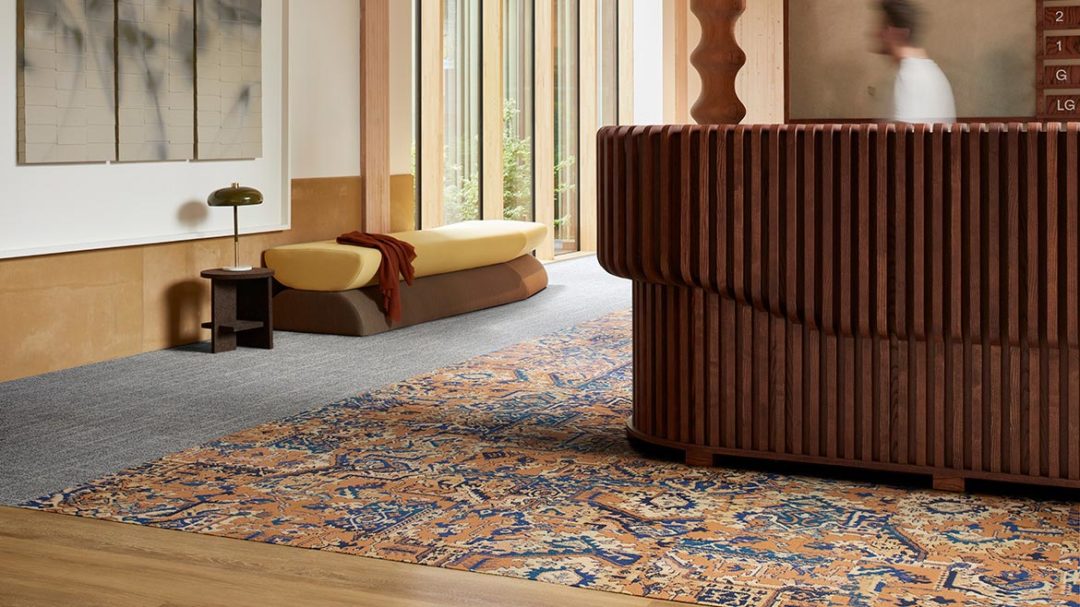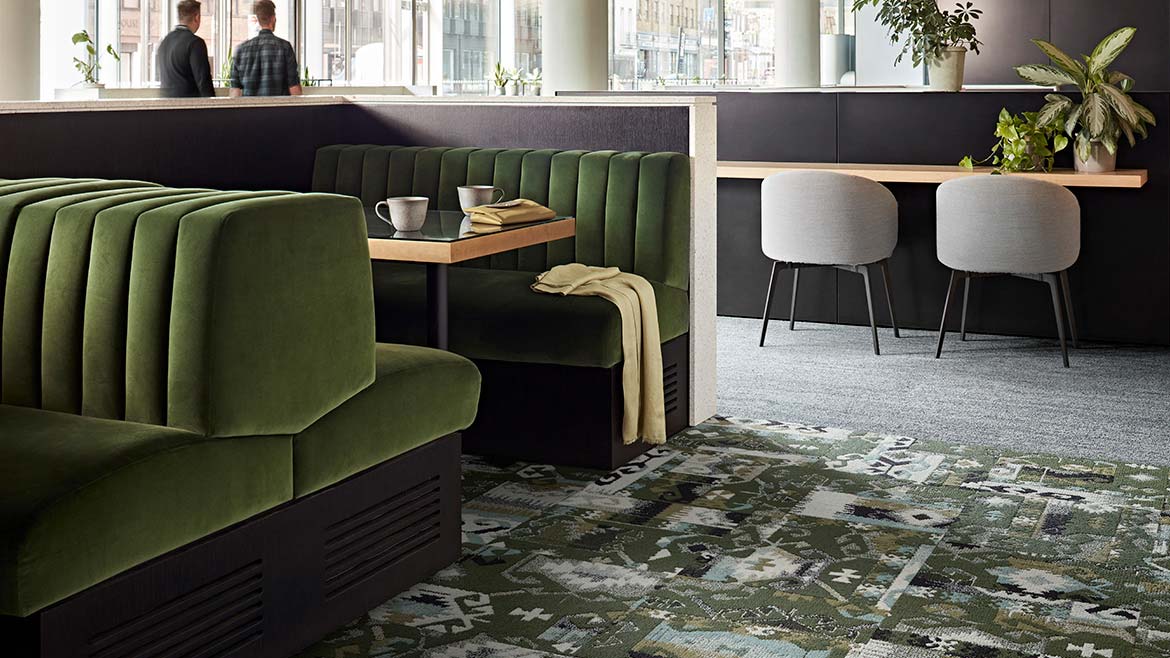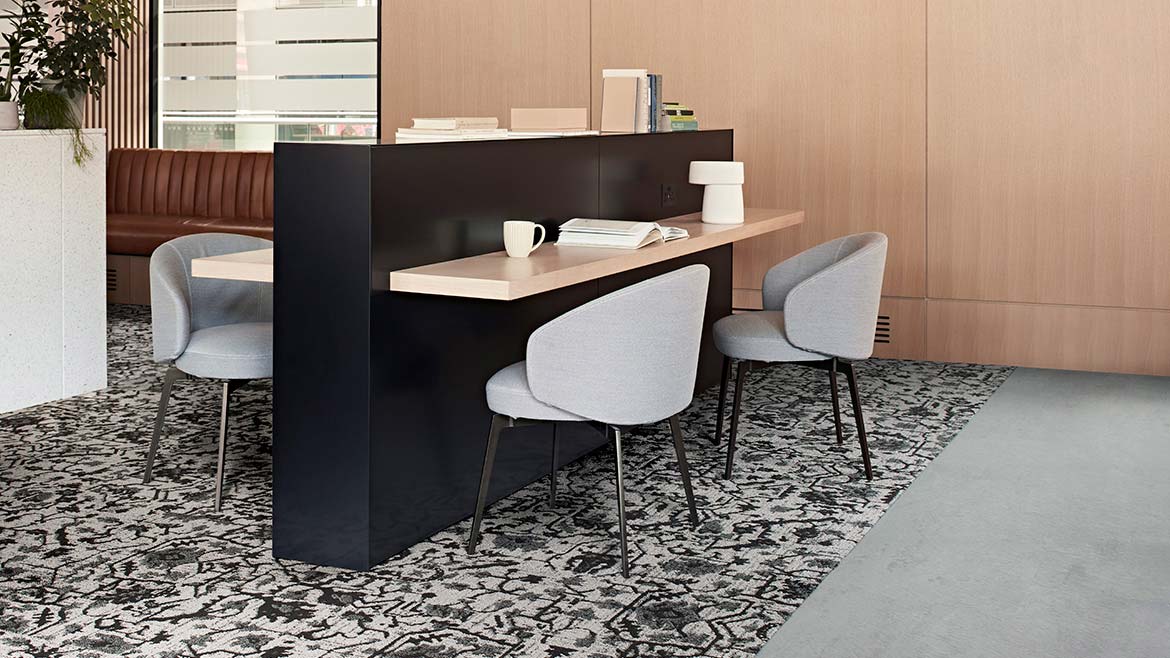Carpet Design in Commercial Spaces: Interface Celebrates 50 Years of Innovation

Retrospec in Olive. Photo: Interface.

Circa Then in Fern. Photo: Interface.

Archival in Parchment. Photo: Interface.

Antiquities in Coral. Photo: Interface.

Decades in Ebony. Photo: Interface.





A lot has changed in flooring design since Chip DeGrace, director of design purpose at Interface, first joined the the company in the 1980s.
“I joined because I wanted to practice design more holistically enterprise-wide,” he said. “I wanted to find a company that I could dig in and represent them in every possible dimension—not only in product but also in communications, interiors, buildings—every possible expression.”
Carpet design today looks nothing like the monolithic surfaces that adorned offices back in the day, and DeGrace has helped shape its transformation. He has worn many hats for the global modular flooring producer, which celebrates its 50th anniversary this year. He also helped launch Flor, Interface's premium design brand, which brought high-end area rugs to residential and commercial spaces 20 years ago.
We sat down with DeGrace to discuss some of carpet tile’s construction and design milestones, Interface’s noteworthy accomplishments over the course of 50 years, and what’s on the design horizon. The following are excerpts of our conversation, which you can listen to in its entirety below.
FLOOR Trends & Installation: What's been the most significant change that you've seen in carpet tile?
DeGrace: I think it's growth. In the early 1990s, we were saying, “Why carpet tile?” People just didn't get it. They're like, "Why would I specify this stuff?" As ubiquitous as it is, it literally is around the globe in every sector you can imagine, including people's homes now. The impact I think that it has when it's deftly put on the floor and combinations of color, pattern, texture with other materials, the impact that it has on those people's behavior and their wellness is huge. Carbon footprint-wise, its impact can be really big, or it can be a contributor to an institution, a company's ability to reduce their footprint.

A retro Interface product installation in an office setting. Photo: Interface.
FLOOR Trends & Installation: What has changed over the years in color, pattern and design?
DeGrace: The design of the product is obviously the aesthetics. When we first started, we used a process that was not a non-sewn technology. Today, it's all sewing machines. We didn’t use that. We had a different technology. The pattern that we applied was pretty rudimentary. It was actually a printed pattern, and it was small and overall, it was there to mimic broadloom carpet. There wasn't much asked of aesthetics in the late ’80s, early ’90s. But where it has gone, it is the one finish that you touch every day all the time. I think that variations in tactile quality, color and pattern are endless scale.
Bringing nature in has been a big thing for the last 20-plus years. Having the scale of flooring to add subtle but big-scale pattern under workstations or through a higher education space. That ability has also been something that's been cool to see.
FLOOR Trends & Installation: When was carpet tile originally introduced?
DeGrace: It was actually produced in the ’50s in Europe. Most of the technology that has come from Europe has subsequently been reinvented and as much technology in modern times as here in the States.
In the ’50s, it was this hairy looking stuff. It was felted. It was from a company called Heuga, that we ultimately purchased. Fusion bonding was this non-sewn technology that was invented in France and in Germany, two different technologies. It wasn't viable. It was used for broadloom, and I think they made some carpet tile, but really it was more for the residential space, it was never really applied to commercial.
Ray Anderson, our founder, was one of the pioneers of this because he traveled overseas, saw this technology and knew that in commercial space, certainly in the U.S., that this was going to be cool because what was going on was they were putting grandma's rolled carpet under workstations where all the technology was underneath it. They had to use box cutters to access the carpet to access the technology. He thought the technology that he saw could be reinvented for the commercial space and give carpet tile the ability to act more like furniture systems or more systems-based solutions than paint where you just put it down and hope for the best. I think we were the first ones to commercially produce a product in the United States that would lay flat on the ground and be used for commercial office space and for institutional space.
FLOOR Trends & Installation: Could you walk us through some of milestones of carpet tiles construction and design?
DeGrace: The most critical thing is that carpet tile needed to lay flat on the ground. It was like the origin of the auto industry. There were a lot of people that were trying to do it. I think Interface was the first one to create something that we called free lay. It actually laid on the slab with this big grid of adhesive, but the grid was like 20 feet in diameter and that was just there to hold the grid while you were putting it down. It ostensibly laid on the ground by itself so it's releasable. You could move it around and change it and ultimately recycle it, too.

In the ‘80s, “Offices were full of cubicles and monolithic carpet,” said DeGrace. Photo: Interface.
Having a free lay carpet tile, something that laid flat, not like a potato chip and you could pick it up in the early days when a cup of coffee was spilled and move it around or renew a space or make it cool. I think that was a significant accomplishment.
In the ’90s, with the inception of sort of a nature-based overlay on our design, we started to say,
"Why does carpet tile need to look like grandma's carpet? Why doesn't it look like broadloom? Why are we trying to imitate broadloom carpet at this point?" So, we said, "What if every carpet tile was different?"
You can make repeats that were huge like 20 feet long and two meters wide, and when you cut that up, it was something we called i2. It was like a forest floor. If you pulled the tile, you wouldn’t know it. So, this thing we called i2 was a huge transformation in our business. Every tile can be different and that actually enhances its performance and its flexibility and its wearability and its changeability.
We inspired one of our partners, Aquafil, to produce 100% nylon. That was a big deal. It was not achievable. A lot of credit goes to Aquafil. Inspiring that has created all kinds of benefits for our industry. A lot of our competitors use that product now and in other industries.
FLOOR Trends & Installation: As a designer, is there one particular product that you connect with?
DeGrace: Human Nature and Net Effect—some of those early transition products were super cool. They were hugely variant from highly textured modeled material to utilitarian things that could go under workstations or under learning typologies. I think the coolest thing is that this is a system, it's a vocabulary, so it's how one product works with another. And I think, across the board, when you start to use our material, not just our carpet products, but we also make some resilient products, they all work together.
FLOOR Trends & Installation: What are some of Interface’s most noteworthy accomplishments over the course of 50 years?
DeGrace: What’s amazing is that we're in the residential business, too. We started the business in 2002 to take it to the consumer. What was cool about that is that a lot of the same benefits that you find at large scale, meaning moveability and cleanability and performance and recyclability, all those things at a small scale for a dining room are equally as compelling. It was cool to meet people in their homes to solve some of the same problems that you would have on the commercial side.
In think the fact that 66% of all the materials that we use to make our products are for recycled and bio-based materials. That’s significant, coming from a dead stop in 1994. Our carbon footprint’ s down 79% from base year 1996.
Our 100% recycled nylon thing is huge. To be able to participate with one of our vendor partners to create a recycled circular economy program whereby we help develop systems to bring the carpet back such that Aquafil can actually recycle it and turn it into a 100% recycled product is phenomenal. We actively helped them design that system to actually bring the product back.
Our backing products contribute to a carbon negative product. We have a wide range of backing products, but the fact that they don’t need to be glued to the floor—that was part of the very inception. Then, we developed these little adhesive dots at the corners called TacTiles. You connect one to the other. That allows for ultimate flexibility and recyclability is another significant thing.
The pervasiveness and the ubiquitous nature of carpet in every commercial application and its attractiveness to the dealer community from the installation perspective to the end-use community from a performance perspective to the design community trying to sell real user issues. It’s a great system, and we were part of making that such a great opportunity for all of our customers and all of our influencers.
FLOOR Trends & Installation: What’s on the horizon for Interface?
DeGrace: In the spirit of our 50th year, we're bringing a product out called Past Forward, and it reflects on our history in a little British town called Kidderminster. Some of the classic patterns, these iconic patterns that were done for broadloom carpet were hand painted, hand drawn, we couldn't actually make those into carpet at the time. But technology has grown. We can actually take some of those patterns which now we have to go to the Victoria and Albert Museum (V&A) to get them because we had no use for them, so they are somewhat lost to the ether. But we found some at the V&A and other places. This new product line called Past Forward celebrates those old, historic patterns that are very familiar to people. We've reinvented them for carpet tile vocabulary.
Looking for a reprint of this article?
From high-res PDFs to custom plaques, order your copy today!











